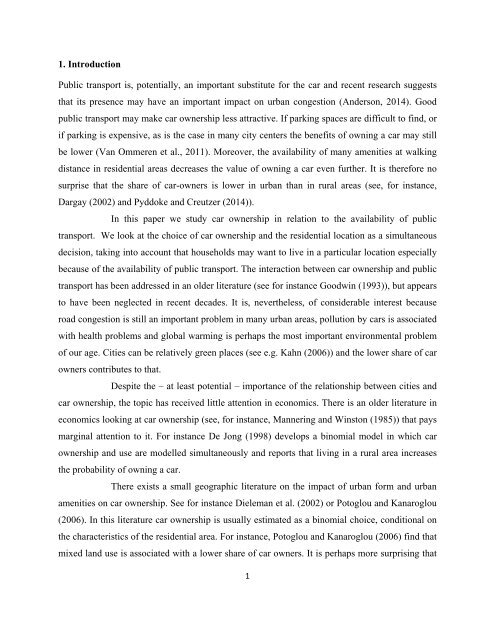Car Ownership? Evidence from the Copenhagen Metropolitan Area
n?u=RePEc:tin:wpaper:20150139&r=dem
n?u=RePEc:tin:wpaper:20150139&r=dem
You also want an ePaper? Increase the reach of your titles
YUMPU automatically turns print PDFs into web optimized ePapers that Google loves.
1. Introduction<br />
Public transport is, potentially, an important substitute for <strong>the</strong> car and recent research suggests<br />
that its presence may have an important impact on urban congestion (Anderson, 2014). Good<br />
public transport may make car ownership less attractive. If parking spaces are difficult to find, or<br />
if parking is expensive, as is <strong>the</strong> case in many city centers <strong>the</strong> benefits of owning a car may still<br />
be lower (Van Ommeren et al., 2011). Moreover, <strong>the</strong> availability of many amenities at walking<br />
distance in residential areas decreases <strong>the</strong> value of owning a car even fur<strong>the</strong>r. It is <strong>the</strong>refore no<br />
surprise that <strong>the</strong> share of car-owners is lower in urban than in rural areas (see, for instance,<br />
Dargay (2002) and Pyddoke and Creutzer (2014)).<br />
In this paper we study car ownership in relation to <strong>the</strong> availability of public<br />
transport. We look at <strong>the</strong> choice of car ownership and <strong>the</strong> residential location as a simultaneous<br />
decision, taking into account that households may want to live in a particular location especially<br />
because of <strong>the</strong> availability of public transport. The interaction between car ownership and public<br />
transport has been addressed in an older literature (see for instance Goodwin (1993)), but appears<br />
to have been neglected in recent decades. It is, never<strong>the</strong>less, of considerable interest because<br />
road congestion is still an important problem in many urban areas, pollution by cars is associated<br />
with health problems and global warming is perhaps <strong>the</strong> most important environmental problem<br />
of our age. Cities can be relatively green places (see e.g. Kahn (2006)) and <strong>the</strong> lower share of car<br />
owners contributes to that.<br />
Despite <strong>the</strong> – at least potential – importance of <strong>the</strong> relationship between cities and<br />
car ownership, <strong>the</strong> topic has received little attention in economics. There is an older literature in<br />
economics looking at car ownership (see, for instance, Mannering and Winston (1985)) that pays<br />
marginal attention to it. For instance De Jong (1998) develops a binomial model in which car<br />
ownership and use are modelled simultaneously and reports that living in a rural area increases<br />
<strong>the</strong> probability of owning a car.<br />
There exists a small geographic literature on <strong>the</strong> impact of urban form and urban<br />
amenities on car ownership. See for instance Dieleman et al. (2002) or Potoglou and Kanaroglou<br />
(2006). In this literature car ownership is usually estimated as a binomial choice, conditional on<br />
<strong>the</strong> characteristics of <strong>the</strong> residential area. For instance, Potoglou and Kanaroglou (2006) find that<br />
mixed land use is associated with a lower share of car owners. It is perhaps more surprising that<br />
1


